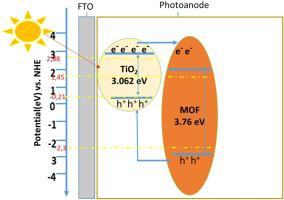Journal of Photochemistry and Photobiology A: Chemistry ( IF 4.1 ) Pub Date : 2020-12-01 , DOI: 10.1016/j.jphotochem.2020.113063 William Moloto , Pontsho Mbule , Edward Nxumalo , Bulelwa Ntsendwana

|
This work reports on the effect of zinc(II)-benzene-1,3,5-tricarboxylate metal organic frameworks (Zn-BTC MOFs) towards enhancing the power conversion efficiency of titanium dioxide (TiO2) based dye-sensitized solar cells (DSSCs). Zn-BTC MOFs and TiO2 nanoparticles were synthesized via a modified hydrothermal method. This was followed by the addition of an extrinsic mixture of TiO2 powder and MOFs to form TiO2-Zn-BTC MOF(2%), TiO2-Zn-BTC MOF(4%) and TiO2-Zn-BTC MOF(6%) nanocomposites with varying concentrations. The structure, morphology, optical properties and thermal stability of the MOF powders were subsequently evaluated. XRD analysis demonstrated that the incorporation of MOFs into TiO2 decreases the crystallinity of TiO2 due to the poor crystalline structure of MOFs. The presence of the Ti-C bond and the induced redshift of the E1g peak suggesting the migration of electrons between TiO2 and MOFs was confirmed by FTIR and Raman spectroscopy, respectively. Microscopic studies showed the formation of irregularly shaped nanoparticles with a size range of 5–40 nm. Additionally, the BET surface area improved with an increase in Zn-BTC loadings, leading to the uniform dispersion of TiO2 nanoparticles in the nanocomposites. The optical properties of the nanocomposites were enhanced by the incorporation of Zn-BTC MOFs resulting to low band gap values. The TiO2-Zn-BTC MOF(2%) exhibited a lower band gap of 2.9 eV in comparison to TiO2-Zn-BTC MOF(4%) with a band gap of 3.1 eV and TiO2-Zn-BTC MOF(6%) which also had a band gap of 3.1 eV. Hence, TiO2-Zn-BTC MOF(2%) exhibited reduced recombination rates of the electron-hole pairs and increased photoactivity as confirmed by the photoluminescence (PL) spectroscopy data, as well as reduced charge-transfer kinetics shown by electrochemical impedance results. The I–V results showed that TiO2-Zn-BTC MOF(2%) has a strong ability to act as an effective electron transporter which significantly enhanced the photoefficiency of TiO2 thus leading to better photoanodes for DSSCs.
中文翻译:

锌(II)-苯-1,3,5-三羧酸金属金属骨架对染料敏化太阳能电池用TiO 2光阳极性能的稳定作用
这项工作报告了锌(II)-苯-1,3,5-三羧酸金属有机骨架(Zn-BTC MOF)对提高基于二氧化钛(TiO 2)的染料敏化太阳能电池的功率转换效率的作用( DSSC)。通过改进的水热法合成了Zn-BTC MOF和TiO 2纳米粒子。然后添加TiO 2粉末和MOF的外在混合物,形成TiO 2 -Zn-BTC MOF(2%),TiO 2 -Zn-BTC MOF(4%)和TiO 2浓度不同的-Zn-BTC MOF(6%)纳米复合材料。随后评估了MOF粉末的结构,形态,光学性质和热稳定性。XRD分析表明,由于MOF的不良晶体结构,将MOF掺入TiO 2降低了TiO 2的结晶度。Ti-C键的存在和E 1 g峰的诱导红移表明电子在TiO 2之间迁移FTIR和拉曼光谱分别证实了MOF和MOF。显微镜研究表明,形成了尺寸范围为5-40 nm的不规则形状的纳米颗粒。另外,BET表面积随Zn-BTC负载量的增加而改善,从而导致TiO 2纳米颗粒在纳米复合物中的均匀分散。通过掺入Zn-BTC MOF增强了纳米复合材料的光学性能,从而降低了带隙值。TiO 2 -Zn-BTC MOF(2%)的带隙低于2.9 eV,而TiO 2 -Zn-BTC MOF(4%)的带隙为3.1 eV和TiO 2 -Zn-BTC MOF(2%)较低。6%),其带隙也为3.1 eV。因此,TiO 2-Zn-BTC MOF(2%)表现出的电子-空穴对重组率降低,光活性增强,如通过光致发光(PL)光谱数据所证实,以及电化学阻抗结果所示的降低的电荷转移动力学。I–V结果表明,TiO 2 -Zn-BTC MOF(2%)具有有效的电子转运体的强大功能,可显着提高TiO 2的光效率,从而为DSSC提供更好的光阳极。











































 京公网安备 11010802027423号
京公网安备 11010802027423号